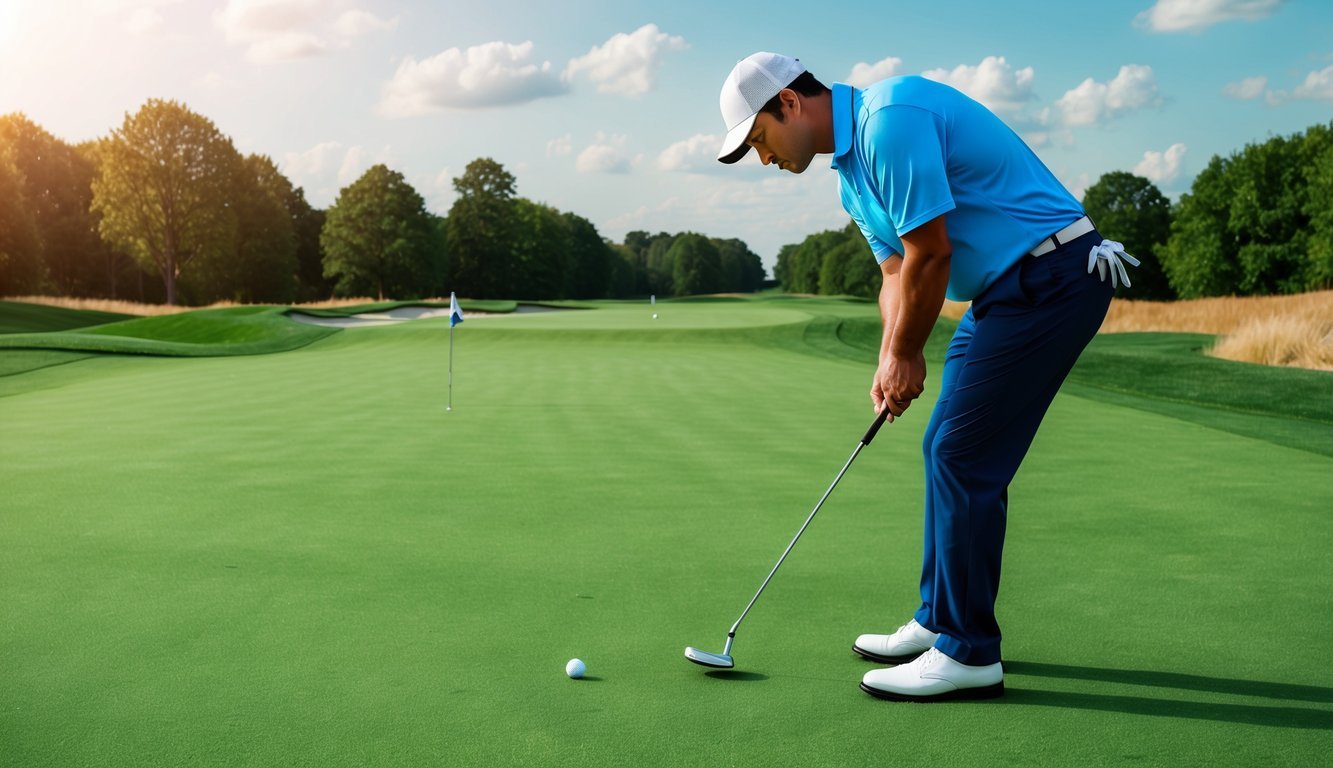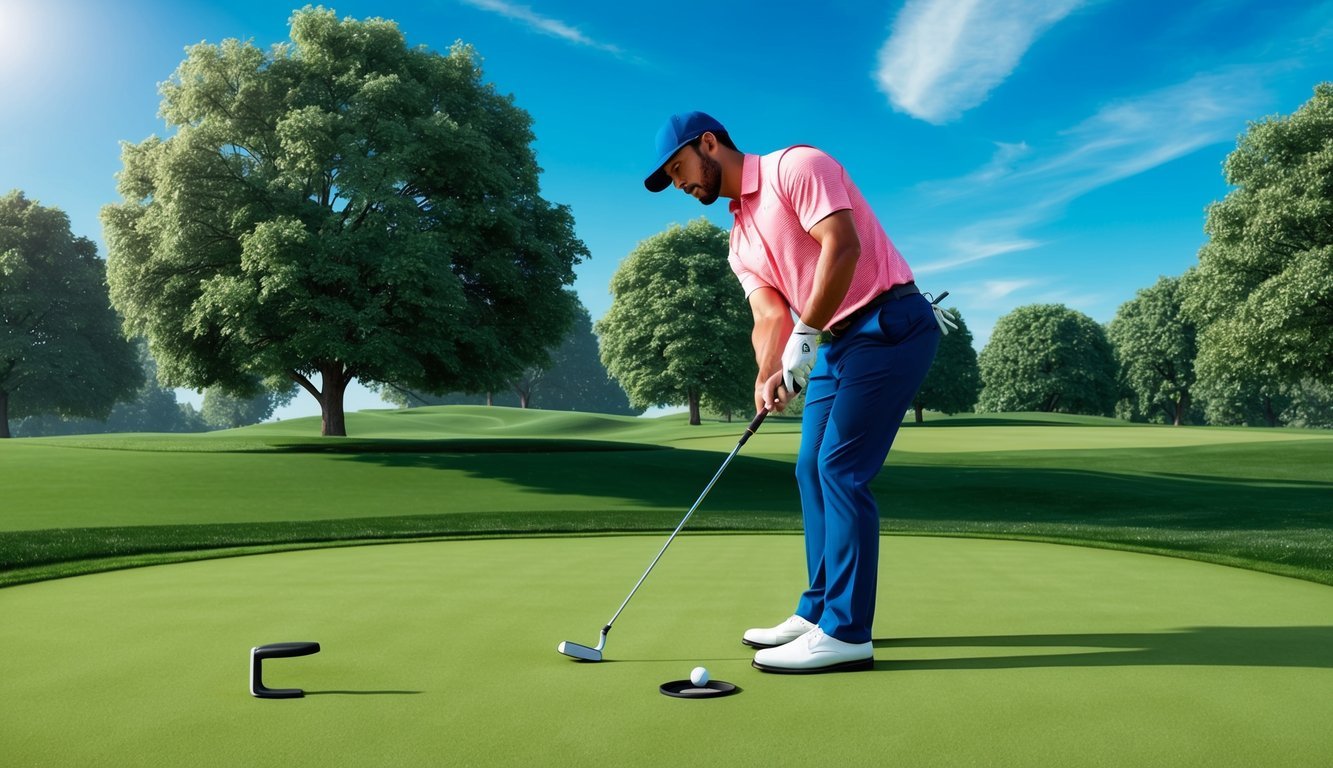Choosing the right putter is a crucial step for anyone new to golf.
As a beginner, you need to find a putter that suits your playing style and enhances your confidence on the green. The best putters for beginners often balance forgiveness, alignment aids, and affordability to provide the best learning experience.
Whether you’re seeking stability or a softer feel, there’s a perfect putter out there for you.

When you begin your search, consider putters that offer ease of use and comfort.
Models like the Odyssey Stroke Lab Triple Track Putter, noted for its premium features, can significantly improve game play for high handicappers and novices alike.
Alternatively, if you’re watching your budget, the Inesis High MOI Putter promises reliability and excellent alignment at a more accessible price point.
Check out selections like the Odyssey Stroke Lab and Inesis High MOI Putter for excellent options.
Exploring different putter types and familiarizing yourself with the key characteristics, such as head shape and weight distribution, will greatly benefit your game.
Beyond just picking the right equipment, practical tips for practice can enhance your skills.
Embrace trial and error, and soon you’ll find the putter that feels like an extension of your own arm.
Key Takeaways
- Find a putter that is forgiving and aligns easily.
- Consider price and features like head shape for your putter.
- Practice regularly to enhance your putting skills.
Understanding Putter Types
When choosing a putter, understanding its various components can greatly enhance your performance.
From the putter head design to the length and style, each element plays a significant role in how you feel and control the putt.
Each type offers unique benefits, making it essential to find what matches your play style.
Mallet vs. Blade Putters
Mallet putters feature larger heads with a high moment of inertia (MOI), providing more stability and forgiveness on miss-hits.
They often include alignment lines which aid in aiming more accurately.
These putters are heavier and typically better for golfers who prefer a straight-back, straight-through putting stroke.
In contrast, blade putters have a smaller, more traditional head shape.
They are lighter and well-suited for players with an arc stroke style.
Some golfers find they offer a softer feel and more control over longer putts.
Choosing between a mallet and a blade putter depends largely on your stroke style and personal preference.
Importance of Putter Length
Putter length directly affects your posture and eye alignment over the ball.
Common lengths range from 32 to 36 inches.
A putter that is too long or short can lead to inconsistent putts.
Your putting stance should feel comfortable, allowing you to keep your eyes directly over the ball.
To determine the ideal length, check how your arms hang naturally when you address the ball.
Testing different lengths can help you find the most comfortable fit.
Ensuring the correct length promotes a better stroke and improves your overall putting accuracy.
Putter Head Designs and Features
Different putter head designs include not only mallet and blade styles but also variations like milled putters.
Milled putters are made from a single piece of metal for a precise feel and are often favored by players seeking feedback on their strokes.
Head designs may integrate features like perimeter weighting, which distributes weight around the edges for better stability.
Look for designs with clear alignment aids.
These can include lines or dots helping you to square up to the target effectively.
Exploring these variations allows you to find a putter that enhances your skill and confidence on the greens.
Key Putter Characteristics for Beginners

When you’re selecting a putter as a beginner, several characteristics can help make your experience more forgiving and accurate.
Focusing on features like the sweet spot, forgiveness, MOI and stability, as well as alignment aids, can lead to improved consistency and distance control in your game.
Sweet Spot and Forgiveness
A putter with a large sweet spot and high forgiveness level is ideal for beginners.
It helps you achieve more accurate strokes even when your strike location deviates from the center.
Putters designed with a larger sweet spot reduce the impact of off-center hits, enhancing your confidence on the greens.
Forgiveness in a putter means that potential mishits don’t lead to drastic inaccuracies, making your short game more consistent.
A forgiving putter minimizes distance loss on mis-strikes and helps maintain the direction of your putts.
These features are crucial when working to improve your technique and build consistency.
MOI and Stability
MOI, or Moment of Inertia, is a critical factor for putter stability.
A high MOI putter resists twisting during the stroke, providing more consistent ball rolls and accuracy.
This is particularly beneficial on longer putts where keeping a straight path is challenging.
Stable putters help maintain the face angle at impact, leading to better distance control.
Increased stability also lowers the chance of the putter turning unexpectedly, which helps keep your putts on track.
Choosing a putter with a design that emphasizes MOI can enhance your game’s stability and make it easier to achieve desired results.
Alignment Aids and Accuracy
Alignment aids are essential for beginners to set up their shots correctly.
Well-designed alignment features help you position your putter accurately and aim towards your target effectively.
For example, painted lines or embedded markers are common alignment tools that guide your visual field.
Accuracy is closely related to how well your putter lines up with the target, and alignment aids play a significant role in this.
Accurate alignment enhances your chance of sinking more putts, as it boosts confidence in managing direction and distance.
Consistent alignment practices lead to improved putting precision over time, making your game more reliable.
Top Putter Picks for New Golfers
Choosing the right putter is crucial for beginner golfers aiming to enhance their skills on the green.
This section highlights notable options from Callaway, Odyssey, Taylormade, Cleveland, and Wilson, providing insights into their unique features and benefits for newcomers.
Callaway and Odyssey Options
Callaway and Odyssey are renowned for producing some of the best putters for beginners.
The Odyssey White Hot OG Rossie S is particularly popular due to its forgiving nature.
It features a soft insert that helps maintain the golf ball on the target line, minimizing popping or skidding.
Another great option is the Odyssey Stroke Lab series, known for its innovative shaft design, which improves tempo and consistency.
These putters can make a significant difference in how you experience putting, offering precision and control.
If you’re looking for dependability and improved accuracy, these selections are excellent choices to consider.
Taylormade Spider Series
The Taylormade Spider series is celebrated for its advanced technology and sleek design, appealing to new golfers seeking reliability.
The Taylormade Spider X, a standout in this lineup, offers exceptional stability due to its multi-material construction.
Featuring a heavy steel frame and lightweight carbon composite sole, the Spider X enhances perimeter weighting, which helps keep your putts on track.
The Taylormade Spider GT Max Putter is another excellent option, providing adjustable configurations that cater to different stroke preferences.
Both models offer the balance and control that beginners need as they refine their skills.
Cleveland Frontline Models
Cleveland Golf prioritizes forgiveness and stability in their Frontline series, which is well-suited for beginners.
The Cleveland Frontline Cero Putter stands out with its innovative forward-weighted design, ensuring better alignment and accuracy.
The Frontline line-up utilizes Tungsten forward weighting, a unique approach that places more mass closer to the face.
This helps eliminate mishits by providing a more stable and direct ball roll.
New golfers can benefit greatly from this precision-focused engineering, making it easier to improve their putting performance.
Wilson Staff Options
Wilson offers reliable and affordable options for beginners through its Staff Infinite series.
The Wilson Staff Infinite Buckingham Putter is notable for its classic mallet shape and counterbalanced technology, designed to enhance control.
This putter features a double milled face promoting consistent impact, and it effectively reduces skidding upon initial contact.
Wilson putters are praised for their intuitive design, providing ease of use for golfers new to the sport.
With a Wilson putter in your equipment, gaining confidence on the green and honing your skills is just a stroke away.
Enhancing Your Putter Experience

Improving your putting experience involves understanding the role of grip and how feedback influences your play.
These elements are crucial for maintaining a consistent stroke, especially for beginner golfers aiming to improve their short game.
Grips and Their Impact on Your Stroke
Choosing the right grip can significantly influence your putting stroke.
An oversized grip may help reduce wrist action, which can stabilize your stroke and improve alignment.
For those struggling with off-center strikes, experimenting with different grip sizes might make a difference.
Consider grips made of materials that wick moisture, keeping your hands dry for better control.
Additionally, the position and fit of your hands on the grip can affect your feel and speed control.
Staying focused on these details can lead to more consistent performance on the greens.
The Value of Feedback
Receiving and acting on feedback is vital to refining your putt.
Pay attention to how the ball reacts upon impact—this can inform you about issues like alignment or if the hosel impacts your stroke.
A putter that provides immediate sensory feedback offers vital cues.
Look for putters with built-in alignment aids to better judge and correct your stance.
Equipment that highlights mis-hits can assist in diagnosing problems and developing a more precise, consistent stroke.
Understanding feedback leads to an enhanced forward roll and improved performance overall.
Practical Tips for Practicing

Improving your putting game requires regular practice and focusing on key areas like stance, grip, and alignment.
Start with the basics: work on your stance.
Keep your feet about hip-width apart and your knees slightly bent.
Remember, the positioning of your hands can influence your accuracy, so ensure your grip remains consistent.
Visit the practice greens as often as you can.
Short putts, especially those within six feet, are crucial for building confidence and consistency in your short game.
Take time to develop a routine that you can apply on the course.
Emphasize repetition to create muscle memory.
Incorporate drills into your practice sessions.
One effective drill involves picking two holes about 20-30 feet apart.
Putt back-and-forth using one ball; aim to make two-putts or fewer consistently.
This kind of practice emphasizes distance control and helps refine your touch.
Alignment technology can also be beneficial.
Using tools or putters that help with alignment can improve your aim and ball direction.
Many modern putters are equipped with alignment aids to guide your stroke path.
Consider the craftsmanship of your putter.
A well-crafted putter can enhance your feel and control, allowing for a more natural connection with the ball.
Make sure your equipment suits your personal style and comfort.
Organize your practice into manageable time blocks to maintain focus and prevent fatigue.
This structured approach ensures you get the most out of each practice session and helps maintain a high level of engagement.

